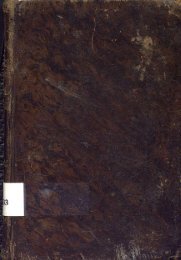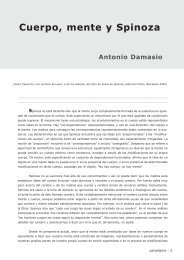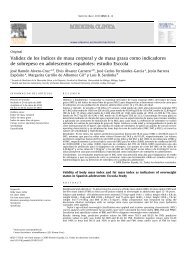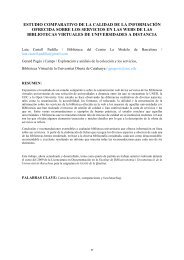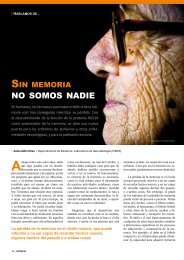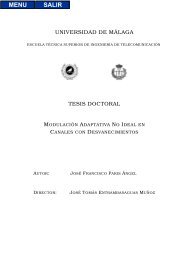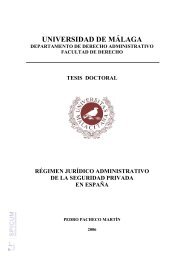Papel de las actividades superóxido dismutasa y catalasa en la ...
Papel de las actividades superóxido dismutasa y catalasa en la ...
Papel de las actividades superóxido dismutasa y catalasa en la ...
Create successful ePaper yourself
Turn your PDF publications into a flip-book with our unique Google optimized e-Paper software.
Journal of Fish Diseases 2006, 29, 355–364<br />
PDíaz-Rosales et al. Superoxi<strong>de</strong> dismutase and cata<strong><strong>la</strong>s</strong>e in P. damse<strong>la</strong>e ssp. piscicida<br />
Multiplication of P. damse<strong>la</strong>e ssp. piscicida insi<strong>de</strong><br />
several fish cell lines has also be<strong>en</strong> reported. Elkamel<br />
& Thune (2003) observed that the bacteria multiply<br />
in EPC, CCO, and FHM cells and López-<br />
Dóriga, Barnes, dos Santos & Ellis (2000) using<br />
EPC cells observed that both virul<strong>en</strong>t and avirul<strong>en</strong>t<br />
iso<strong>la</strong>tes were able to adhere to and inva<strong>de</strong> cells.<br />
Results obtained from this study show that<br />
P. damse<strong>la</strong>e ssp. piscicida is able to survive insi<strong>de</strong><br />
sole phagocytes at least for 5 h, the survival rates<br />
being higher for the virul<strong>en</strong>t iso<strong>la</strong>te. Although the<br />
bacterium was able to survive, the rates obtained<br />
always indicated a certain <strong>de</strong>gree of bacterial<br />
inactivation insi<strong>de</strong> phagocytes.<br />
Survival of the non-virul<strong>en</strong>t strain in contact with<br />
sole phagocytes was significantly lower compared<br />
with the virul<strong>en</strong>t strain. The non-virul<strong>en</strong>t strain also<br />
showed lower cata<strong><strong>la</strong>s</strong>e activity. These results suggest<br />
that bacterial inactivation could be due to the<br />
accumu<strong>la</strong>tion of hydrog<strong>en</strong> peroxi<strong>de</strong>, the precursor<br />
of hydroxyl radicals, after <strong>de</strong>composition of superoxi<strong>de</strong><br />
radicals by bacterial SOD. This accumu<strong>la</strong>tion<br />
would not take p<strong>la</strong>ce to such an ext<strong>en</strong>t in the virul<strong>en</strong>t<br />
strain, as levels of cata<strong><strong>la</strong>s</strong>e are higher. The important<br />
role of cata<strong><strong>la</strong>s</strong>e in the protection against oxidative<br />
damage in P. damse<strong>la</strong>e ssp. piscicida has be<strong>en</strong> pointed<br />
out by Barnes et al. (1999a), who observed that the<br />
addition of exog<strong>en</strong>ous cata<strong><strong>la</strong>s</strong>e to the medium<br />
protected the bacteria from inactivation by photochemically<br />
g<strong>en</strong>erated superoxi<strong>de</strong> anions.<br />
Both virul<strong>en</strong>t and non-virul<strong>en</strong>t strains assayed by<br />
Barnes et al. (1999a) showed high susceptibility to<br />
cell-free g<strong>en</strong>erated superoxi<strong>de</strong> radicals. In contrast,<br />
we have observed that a non-virul<strong>en</strong>t strain, EPOY-<br />
8803-II, is significantly more susceptible to killing<br />
by sole phagocytes than a virul<strong>en</strong>t strain (Lg h41/01 ).<br />
Besi<strong>de</strong>s the lower cata<strong><strong>la</strong>s</strong>e activity pres<strong>en</strong>t in the<br />
non-virul<strong>en</strong>t strain, the <strong>la</strong>ck of a capsule in cells of<br />
EPOY-8803-II could contribute to the high inactivation<br />
rates observed. Thus, the capsule could<br />
protect bacterial cells from oxidative radicals or ev<strong>en</strong><br />
prev<strong>en</strong>t activation of phagocytes (Miller & Britigan<br />
1997; Arijo et al. 1998).<br />
The important role of iron in microbial infections<br />
has be<strong>en</strong> pointed out by several authors<br />
(Miller & Britigan 1997; Weinberg 2000). The<br />
pathog<strong>en</strong> needs to obtain iron from the host, where<br />
this metal is linked to high-affinity proteins and<br />
iron avai<strong>la</strong>bility is very low; also, a transition metal<br />
catalyst such as iron p<strong>la</strong>ys an important role in the<br />
g<strong>en</strong>eration of hydroxyl radicals in vivo. In<strong>de</strong>ed, at<br />
physiological pH, g<strong>en</strong>eration of hydroxyl radical<br />
from hydrog<strong>en</strong> peroxi<strong>de</strong> and superoxi<strong>de</strong> anions is of<br />
little biological importance unless a metal such as<br />
ferric iron is pres<strong>en</strong>t (Haber–Weiss reaction) (Miller<br />
& Britigan 1997). Photobacterium damse<strong>la</strong>e ssp.<br />
piscicida is more susceptible to killing by sole<br />
phagocytes wh<strong>en</strong> bacterial cells have be<strong>en</strong> cultured<br />
un<strong>de</strong>r iron-<strong>de</strong>pleted conditions. This could be due<br />
to the lower levels of cata<strong><strong>la</strong>s</strong>e <strong>de</strong>tected in both the<br />
virul<strong>en</strong>t and avirul<strong>en</strong>t cells, the lowest rates corresponding<br />
to strain EPOY-8803-II. Thus, although<br />
the pres<strong>en</strong>ce of iron in <strong>en</strong>vironm<strong>en</strong>ts where superoxi<strong>de</strong><br />
and hydrog<strong>en</strong> peroxi<strong>de</strong> are g<strong>en</strong>erated, such as<br />
in phagocytes, may promote the g<strong>en</strong>eration of<br />
highly toxic hydroxyl radicals, it is also true that<br />
bacteria require iron for growth and replication and<br />
synthesize SOD and cata<strong><strong>la</strong>s</strong>e to <strong>de</strong>al with the<br />
oxidizing anions. Thus, the ability to obtain iron<br />
from the host seems to be crucial for P. damse<strong>la</strong>e<br />
ssp. piscicida. In<strong>de</strong>ed, it has be<strong>en</strong> <strong>de</strong>monstrated that<br />
immune-activated macrophages modify intracellu<strong>la</strong>r<br />
distribution and damp<strong>en</strong> iron influx in or<strong>de</strong>r to<br />
diminish iron avai<strong>la</strong>bility for inva<strong>de</strong>rs (Weinberg<br />
2000).<br />
Photobacterium damse<strong>la</strong>e ssp. piscicida posses a<br />
high-affinity iron uptake system (Magariños et al.<br />
1994; Naka, Hirono & Aoki 2005). However,<br />
<strong>de</strong>spite its ability to obtain iron from high-affinity<br />
systems, several authors have reported that cells<br />
grown un<strong>de</strong>r iron-limited conditions have a<br />
reduced amount of capsu<strong>la</strong>r material covering the<br />
cells (Do Vale, Ellis & Silva 2001). These cells with<br />
reduced capsule would be more susceptible to<br />
phagocytosis and oxidative stress. Our results show<br />
that iron p<strong>la</strong>ys an important role in survival of<br />
P. damse<strong>la</strong>e ssp. piscicida in contact with sole<br />
phagocytes; whether this is attributable to its<br />
contribution to capsu<strong>la</strong>r material or SOD and<br />
cata<strong><strong>la</strong>s</strong>e synthesis by the bacterium needs to be<br />
investigated.<br />
In conclusion, we have shown that P. damse<strong>la</strong>e<br />
ssp. piscicida is able to survive in contact with sole<br />
phagocytes, survival rates being higher for a virul<strong>en</strong>t<br />
strain. The increased levels of cata<strong><strong>la</strong>s</strong>e activity<br />
<strong>de</strong>tected in the virul<strong>en</strong>t strain indicate a possible<br />
role for this <strong>en</strong>zyme in bacterial survival.<br />
Acknowledgem<strong>en</strong>ts<br />
P. Díaz-Rosales thanks the Ministerio Español <strong>de</strong><br />
Educación y Ci<strong>en</strong>cia for a F.P.U. scho<strong>la</strong>rship. This<br />
research has be<strong>en</strong> supported in part by the Research<br />
Project AGL-2002-01488 and PETRI 95-0657.01.<br />
Ó 2006<br />
B<strong>la</strong>ckwell Publishing Ltd<br />
362



